Birds’ feathers come in a range of beautiful colors, but these vibrant shades aren’t just aesthetically pleasing; they often serve a greater purpose. Colored plumage helps birds identify their own species, attract mates, and camouflage with their environments. Some of these pink birds receive their pigment from natural sources and light refraction, while others gain their gorgeous shade through diet. Wading birds, like flamingoes and ibises, acquire their coloration from the carotene found in shrimp! (The shrimp get their pink color from microscopic algae that naturally produce carotenoids.) The stunning birds on this list have graceful features like flowy crests, slender legs, broad wings, and of course, perfectly pink feathers. Discover 7 elegant types of pink birds, including how to identify them and where they live.
American Flamingo
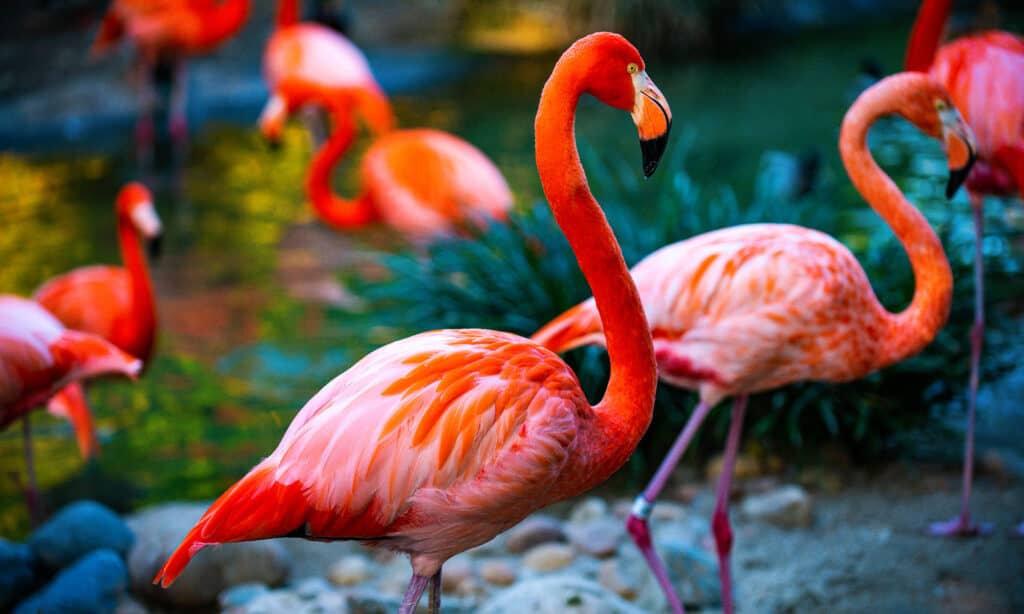
American flamingoes have bright reddish-pink feathers and long, gracefully curved necks.
©Volodymyr TVERDOKHLIB/Shutterstock.com
The American flamingo is a beautiful pink bird native to the Americas and the only flamingo that naturally occurs in North America. This super model of birds features a long, gracefully curved neck and slender legs, along with multiple varying shades of reddish-orange-pink feathers. This species also has black tips on its wings and beak.
These elegant birds breed in tropical areas in South America’s northern tip (Brazil, Ecuador, Colombia, Venezuela), the West Indies, Louisiana, and southern Florida. Their preferred habitats include lagoons, mudflats, and shallow coastal lakes. You can also find them in brackish inland lakes on occasion.
Their bright pink color comes from their diet, which is rich in algae and shrimp. And you can often find these birds standing in their favorite pose: on one leg, the other leg tucked behind their abdomen, and their head resting on their body.
Scarlet Ibis
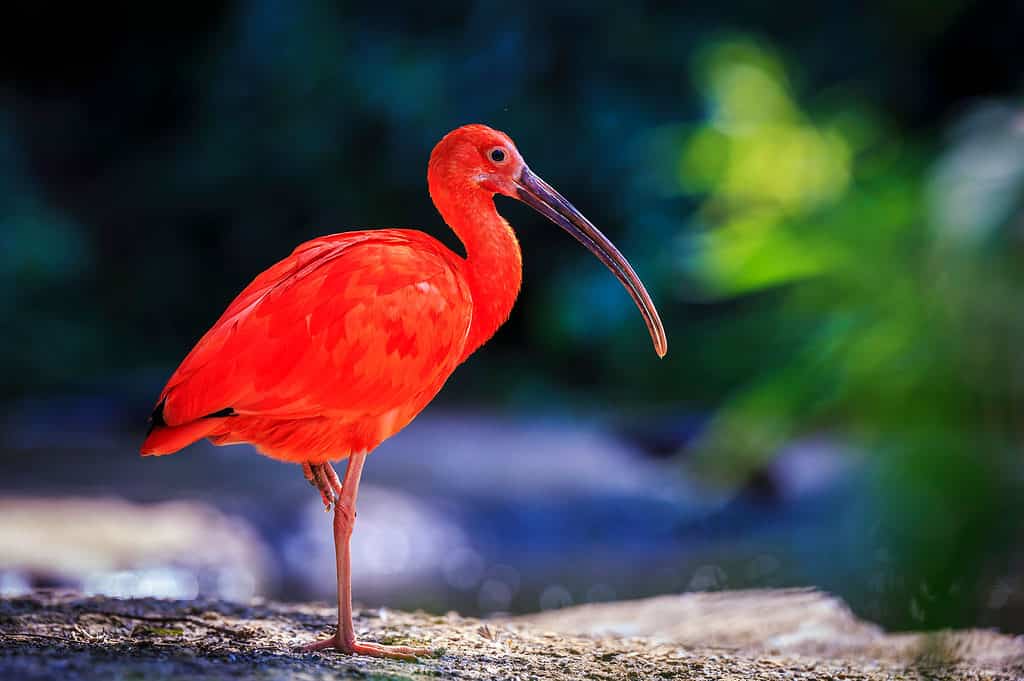
The ibis has a long, slender bill, a long neck, and long legs.
©SanderMeertinsPhotography/Shutterstock.com
The scarlet ibis is a medium-sized tropical wader native to South America. Its brilliant scarlet plumage, which covers its entire body, is unmistakable in the animal kingdom. They feature black or dark blue tips on their primary wing feathers, red bills with black tips, and red feet. Like other wading birds, the ibis has a long, slender bill, perfect for probing for food. It also has a long neck and fairly long legs.
They live in large colonies around South America and the Caribbean Islands, and their highest concentration is in western Venezuela and eastern Colombia. These brightly colored birds inhabit various wetlands and marsh habitats like mudflats, rainforests, and coastlines.
Like flamingoes, they also get their neon color from carotene found in crustaceans. And while they do eat a lot of shrimp, their preferred diet consists primarily of insects, particularly scarabs and ground beetles.
Pink-Headed Fruit Dove

The pink headed fruit dove has a purple-pink head, throat, and neck, green upperparts, and gray underparts with yellow under tails.
©Nusantara Endemics/Shutterstock.com
Pink-headed fruit doves are multi-colored birds from the pigeon family endemic to Indonesia. Despite their striking plumage, this species is shy and discreet. They have purple-pink heads, throats, and necks, green upperparts, and gray underparts with yellow under tails. This fruit dove also features orange irises, green bills, and Fushia feet.
It lives in southeast Asia in Indonesia, where it inhabits mountain forests in Bali, Java, and Sumatra. They live at moderate altitudes and spend their days eating fruit, like figs and berries, in the upper canopy forest. Their forested and berry-heavy surroundings, combined with their green and pink plumage, provide excellent camouflage from predators. You will often find them by themselves or in pairs, but they occasionally flock in groups of 20 at their favorite fruit trees.
Pine Grosbeak
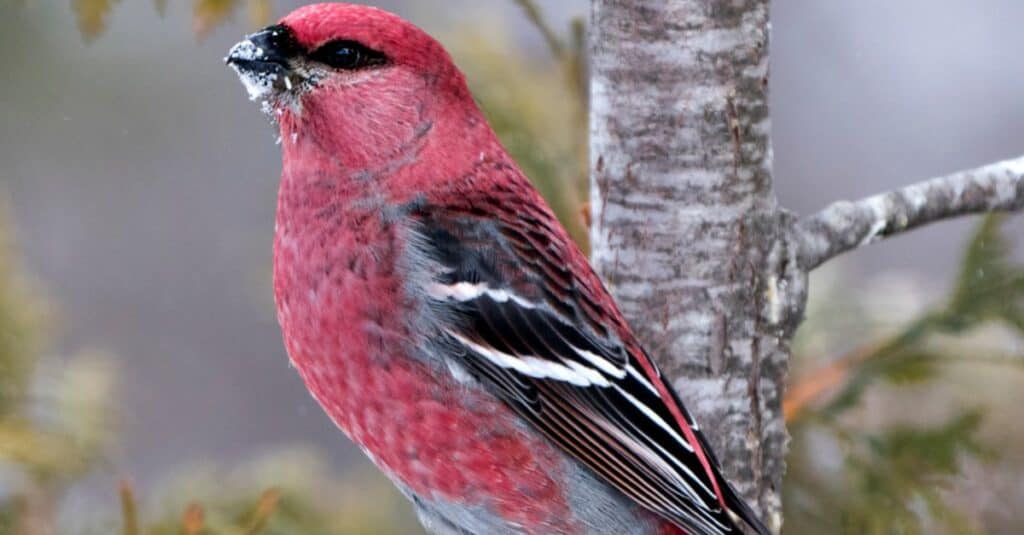
Male pine grosbeaks have rose-colored heads, backs, and rumps.
©iStock.com/Rejean Bedard
The pine grosbeak is a large finch native to North America and Eurasia. They are one of the biggest species in the true finch family, measuring between 8 to 10 inches long on average. This species is sexually dimorphic, with the males featuring rose-colored heads, backs, and rumps and the females possessing olive-yellow feathers. Both sexes have black tails and wings with white wing bars.
They live in northern Europe, Asia, Canada, and the northern United States. The pine grosbeak either remains in its environment year-round or migrates short distances to the southern end of its range. This species prefers open evergreen forests with pine, spruce, and fir trees. You can find them perched on branches, using their thick bills to eat seeds and break off tree buds and needles.
Roseate Spoonbill
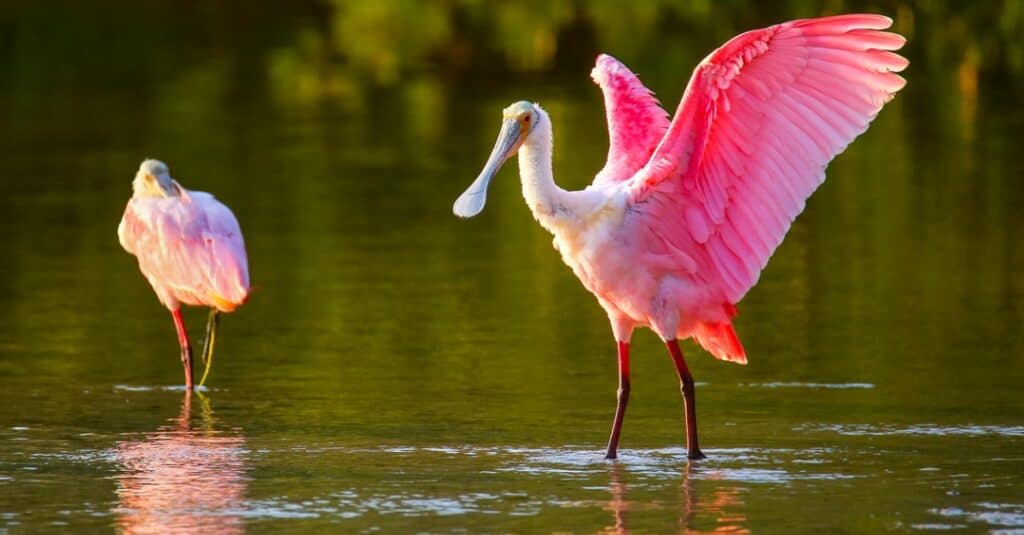
The roseate spoonbill’s feathers range in color from pale pink to bright Fushia.
©iStock.com/Donyanedomam
The roseate spoonbill is a large conspicuous wading bird native to North and South America. This species is between 2 and 3 feet long and features a 4-foot wingspan! Their legs, bills, and necks are elongated and known for their light pink plumage. The top of their bare heads is a greenish color, and their necks and backs are white. Most of their feathers are a pale shade, but they can turn bright Barbie-pink depending on their age and location.
Most of their range resides in South America, but they also live along coastlines in the Caribbean, Mexico, Central America, and the Gulf Coast in the United States. Occasionally, this species makes its way as far north as New York and New Hampshire, although this is very rare. You can look for them in marsh-like areas and mangroves in their primary range.
These birds are a sight to behold as they fly in diagonal lines with their legs and necks outstretched, before landing in shallow water. Additionally, they swing their heads in a sideways motion as they walk. And they sweep their bill from side to side as they probe for small fish and crustaceans in the shallow muddy water.
Galah
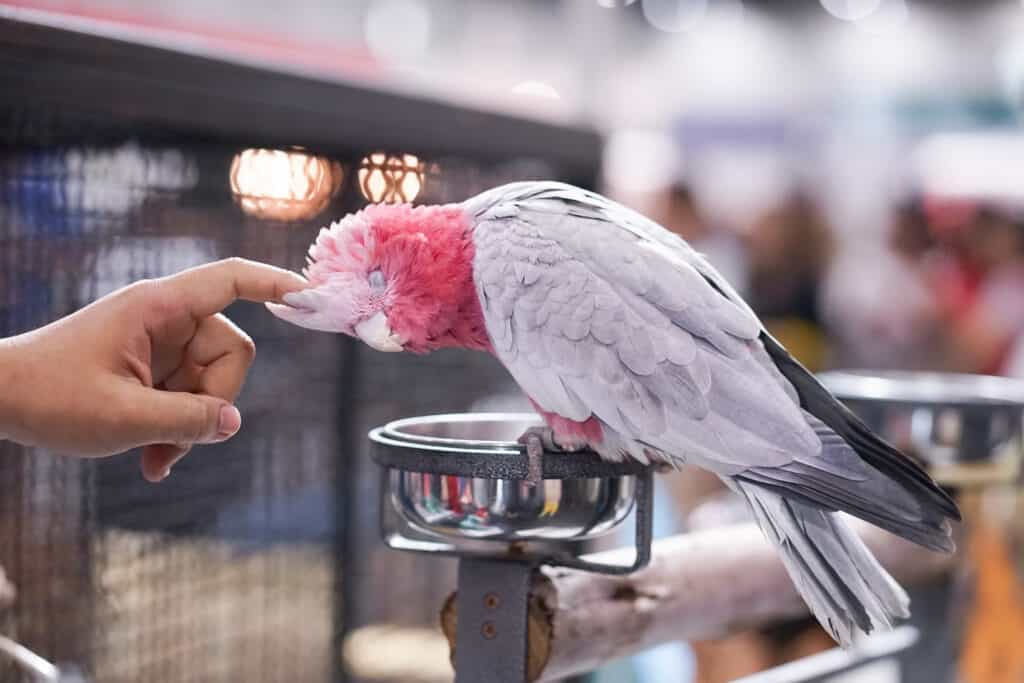
Galahs have pale silver backs and pink faces, necks, and breasts.
©enchanted_fairy/Shutterstock.com
The galah is a chic member of the cockatoo family found in Australia. It is one of the most common cockatoos in its range, and you can find them in rural and urban areas. These birds are around 14 inches long and feature pale silver backs and rumps and candy pink faces, necks, and breasts. They also have light pink crests, light gray bills, and gray legs.
This species inhabits most areas throughout Australia, except for the driest and far northern areas. It also does not inhabit dense forests with a lot of rainfall. Their preferred habitats include woodland, grasslands, and shrublands. But they also live on agricultural land, and in parks and urban areas.
Galahs are relatively social birds, often found in large flocks with mixed species. And they occasionally hybridize with other cockatoo species. They forage in groups on the open ground, feeding on seeds, leaves, and bark. Unfortunately, these pretty birds are the culprits of tree death due to defoliation.
Pink Cockatoo
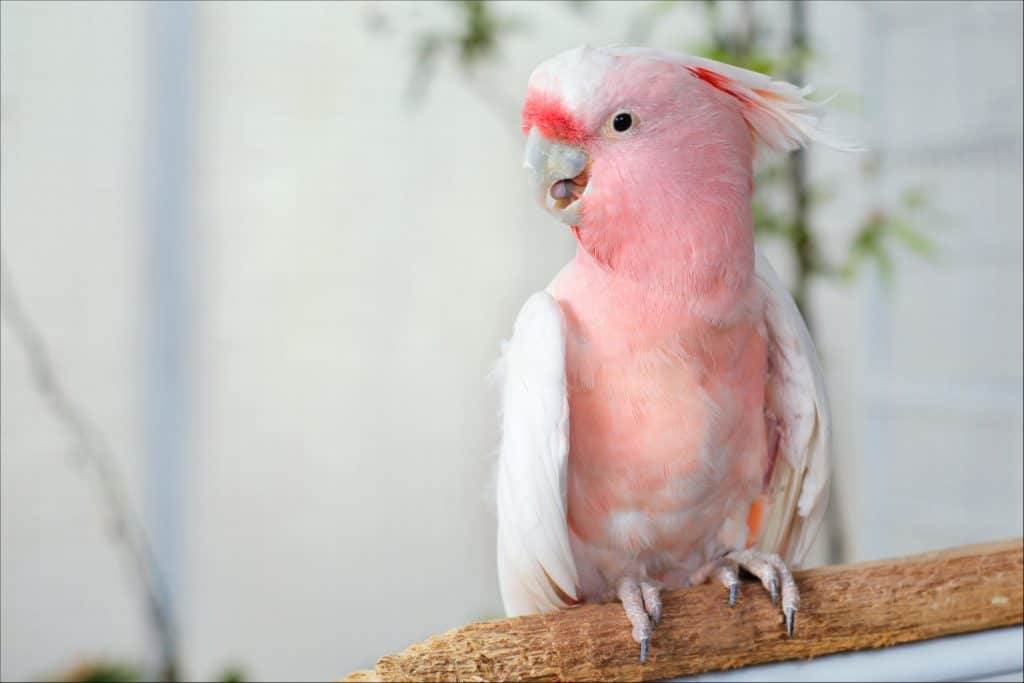
The pink cockatoo may be the most beautiful cockatoo, featuring bright white and pale pink plumage.
©Gatot Adri/Shutterstock.com
The pink cockatoo, also known as Major Mitchell’s cockatoo, is a medium-sized species native to Australia. It is one of the most beautiful cockatoos, featuring stark white and baby pink plumage. It also has a bright red and yellow crest, and males are typically bigger than females.
While galah populations have increased, pink cockatoos have decreased in their range due to man-made structures being built in interior Australia. They live in extensive woodlands and can’t thrive on cleared land. Despite their decreasing habitat, they are not listed as a threatened species. This bird prefers to inhabit conifer and eucalyptus trees, where they nest and roost apart from one another. These cockatoos have impressive lifespans, averaging 40 to 60 years. In fact, the oldest recorded pink cockatoo was 83 years old!
Up Next:
The photo featured at the top of this post is © Roxane 134/Shutterstock.com
Sources
- National Zoo, Available here: https://nationalzoo.si.edu/animals/american-flamingo
- National Zoo, Available here: https://nationalzoo.si.edu/animals/roseate-spoonbill
- Cambridge, Available here: https://www.cambridge.org/core/journals/bird-conservation-international/article/biology-and-conservation-of-pinkheaded-fruitdove-ptilinopus-porphyreus/EEE361DCCE731EBF1AA39F7A7C589C69
- jstor.org, Available here: https://www.jstor.org/stable/1369623
Thank you for reading! Have some feedback for us? Contact the AZ Animals editorial team.






